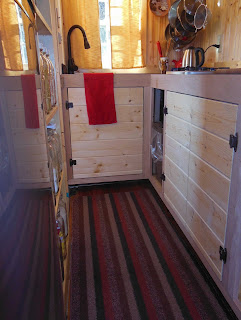Propane is commonly used to heating, cooking and heating water for our tiny homes. Many of us live in the frigid north in our tiny houses. In all areas north of approximately Dallas or Atlanta, we will need some method of heating our home. Many of us are attracted to wood heat and a wood stove. However, even with a wood stove, we need a backup heat source when we are away from our homes to keep plants, internal water tanks and other items from freezing.
Many of us also use propane for cooking and heating water. In this article, I will detail the procedures to install the propane lines. However, if you are unsure of yourself or do not have experience, please get your system tested prior to use. Trust me, a propane explosion can ruin the day of the survivors; not to mention how it can ruin the life of those that do not survive.
I chose to install my propane lines on the exterior of the house. For this application, I recommend black iron pipe. Black iron pipe will not be damaged by road debris during transport of the tiny home. Black iron pipe is available at any quality hardware or big box store. They will even cut to length and thread ends, if requested. Black iron pipe is also easy to work with; you need a pair of gloves, two pipe wrenches, 3/4" pipe and fittings, pipe dope, drill for cutting into the floor and tape measure. My entire propane system including piping, fittings, connections and the propane tank was less than $500.
I am lucky, all my appliances that use propane are on the same side of the house. I have a propane furnace, tanked water heater and a stove. If the appliances were on both sides of the home, it would be easy enough to run a line across with black iron pipe to serve both sides. My water heater and stove are relatively close, I ran one pipe up through the floor and attached a T-fitting. This allowed me to attach two separate valves, one for each appliance.
My furnace is in the living area, I ran a single line up into the living area for the furnace. This line is topped with a gas valve and then flexible gas tubing.
The rest of the pipe is installed under the trailer. I did one large run from rear to forward with two T-fittings. The T-fittings give me the option where to place my propane bottle connection. I have one T-fitting about the mid-point of my trailer so that I could put the propane bottles on the side of my home. I also have a T-fitting at the rear of my home so that I can put my bottles at the rear of my home. Planning now will give you options at a future date.
Long runs of piping are secured with plumbing strapping and also attached to a 1x6 that is secured to the bottom of the trailer. Use sufficient strapping to keep the iron pipe secure.
Properly applying pipe dope is a bit of an art. Place the outlet of the pipe dope tube on the threads of the pipe, push out the sealant so that it completely fills the threads. You do not want any air spaces. Use your hands to push the dope into the threads then apply another coat of sealant over the threads.
Screw the fitting to the pipe and use the two pipe wrenches to tighten the fitting. Clean up excess pipe dope. It is best to not loosen the fittings once tightened. You will want them very tight so be prepared to measure and fit the pipe length during the assembly process. Once the piping is installed, wipe down with mineral spirits to remove oily residue and paint the propane iron pipe and fittings.
Choose the location of your propane tanks. I chose the rear of my home so I needed to cap the T-fitting near the midpoint of my trailer. Use a length of flexible propane hose, 20 feet in length to move the tanks away your home. Most propane company recommend that tanks are at least 20 ft from any residental structure. Attach this hose to your tanks with a propane regulator. You have the option of doing dual tanks but you will need a dual auto-changeover regulator or do this job manually. Make sure, prior to use, that you completely pressure test your system and test for leaks using soapy solution. Prior to first use and after pressure testing, it will take time to bleed the system of air so that your propane appliances will operate. Follow all instructions with your appliances to assure all are connected correctly.
You will need some safety devices such as a carbon monoxide detector, fire extinquisher, etc. I will cover safety items in a future blog post. Go forth and enjoy your cooking, hot water and warm heat from your furnace.





















































